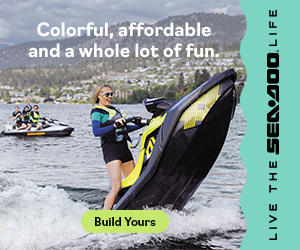
There is a major push coming out of Yamaha’s Kennesaw, Georgia facility that hasn’t been seen in a long, long time. Yamaha is going for blood, and frankly, it’s pretty cool.
Many thought that last year’s introduction of the Super Vortex High Output (SVHO) powertrain package was a major game changer for the brand. And to a degree, they were right. But it’s what Yamaha did with the SVHO – namely charging the Pro Watercross National Tour with a complete roster of top level racers, many of whom publicly defected from Sea-Doo’s X-Team – that first chummed the waters. It’s what’s happening for 2015 that will ignite the air raid sirens.
This weekend was awash with Yamaha Blue on the podium, with Factory Yamaha racers sweeping National Titles in Pro Runabout Open, Limited and Stock, Runabout Naturally-Aspirated, Amateur Runabout Stock, and Expert Runabout Stock. Additionally, SVHO-powered Yamaha bested the offshore favorite Kawasaki Ultra to grab world championships in both the KaruJet and Russki Jetracer offshore enduros.


Emboldened with this unparalleled lead in top end performance, Yamaha is now turning its sights on safety and convenience for 2015, but with a huge splash of improved performance too boot. It’s hard not to just shout out what’s new without mentioning how Yamaha has come to this point:
As the whole PWC industry has improved in overall sales by 25-percent in the last year, Yamaha accounts for 15-percent of that increase. This number makes even more sense when you learn that 80-percent of all Yamaha WaveRunners produced are sold in the US. As sales increase, so does Yamaha’s confidence, and thereby allots us, the enthusiasts, to reap the rewards. What rewards, you ask? Hang on tight:
Replacing Yamaha’s right-hand reverse lever is RiDE, an intuitive “dual throttle control system,” which deploys the reverse bucket in a gradual motion, overriding the throttle progressively. When both throttles are released, the reverse bucket is shifted into a neutral position, letting the runabout idle in place. Controlled by Yamaha’s new Boat Control Unit (BCU), each RiDE unit is specifically tuned to the model to factor for weight and power.


Although Yamaha would really like not to compare it to Sea-Doo’s iBR (Intelligent Brake & Reverse) system, it’s almost impossible not to. Heck, they even have the same little “i” in the name. But, in comparing the two is where Yamaha’s RiDE shines, so we’re gonna do it anyways. Unlike iBR, whose left lever acts as a gear shift, RiDE allows you to reverse freely without the right throttle, as Yamaha’s left-hand trigger is a throttle.
And although not intended for its design, the progressive nature of the reverse bucket does allow for limited full-throttle braking prior to hitting a hard turn. Finding an unsuspecting channel marker to act as our buoy, we continually put Yamaha’s SVHO-powered, RiDE-equipped FX Cruiser through the paces, with the RiDE pulling us back slightly before loading in hot into the turn.
While docking, RiDE pours on the thrust a tad harder than what someone accustomed to iBR might be prepared for. Again, it’s intuitive and requires only the lightest of squeezing to respond. Admittedly, it took a little time to get used to, but it works great. Just don’t let that Yamaha rooster tail spray others on the dock.


Mechanically, the RiDE system uses very similar hardware found on late-model Yamahas, permitting the use of aftermarket ride plates currently available today. Likewise, the reverse bucket retains much of its existing design, including the side exits that funnel thrust to either side (rather than up and down, which tends to nose plow on iBR-equipped skis). And, an electric motor inside the hull manipulates the bucket through a rod, similar to cable-operated reverse buckets today.
And unlike iBR, not all Yamahas are equipped with RiDE, particularly the FZ series skis, as many “hardcore” performance lovers would rather go without the added 14-pounds the system adds, as well as the new V1…wait, what?
That’s right, Yamaha is introducing two new skis to their lineup: the V1 and V1 Sport. OK, when we say “all new” we’re kinda fudging the truth a little. The V1 and V1 Sport is simply the current VX and VX Sport but repackaged and repriced to compete with Sea-Doo’s Spark. Banking that most Sparks sold included add-ons like 3-up seating, front storage and reverse (or iBR), pushing the price closer to $7,000, Yamaha is lowering their two most successful units into this exact price range.


But, wait. That’s not all. Yamaha is unleashing a whole new VX lineup, and we mean from the keel up. Each VX, VXS VXR, VX Deluxe and VX Cruiser features the new RiDE systems, as others feature electronic trim, Cruise Assist and No Wake Mode – y’know, features previously restrained to the larger FX machines. This helps elevate the VX series to a whole new tier of performance, comfort and luxury.
Improving upon the VX was a difficult task, as the series has been not only Yamaha’s, but the industry’s most successful personal watercraft ever sold. The deck of the new VX draws heavily on family DNA pulled down from the FX and FZ units. Likewise, the VX series shed their “cheap” feel with better fit-and-finish, nicer colors, chrome accents and the aforementioned features.
Beneath the bondline though, is where the new VX runabouts really stand out. Scott Watkins explained to The Watercraft Journal, “The goal was to design a hull that if the industry really tanked, it would be able to be ‘everything to everyone.’ We’ve tested it with every engine configuration. We’re really happy with it.”


We spent plenty of time on the VX Cruiser and VXR, and can promise you, these are not the VX series you’re used to. “We had to sacrifice a little bit on the top end to give us the handling characteristics we were looking for,” Scott continued. “It feels quicker, but its how it handles that people will feel the difference.”
And if you think that’s it for 2015, you’d be wrong. Yamaha gave a big nod to the performance-loving PWC enthusiasts by radically improving the SVHO-equipped FZ and FX WaveRunners’ power-to-weight ratio. While the current proprietary NanoXcel material reduces the weight of conventional SMC fiberglass runabouts by upwards of 37-percent, a major revision to Yamaha’s process has found a way to shave another 18-percent over the standard NanoXcel!
Using the new special resin made from “nano” clay and glass micro bubbles that helps to use less material, NanaXcel 2 is used in the development of new stronger, more rigid and lighter decks, liners and hulls. These weight savings add up in a big way: an impressive 35-pounds off of the FZR and FZS and a staggering 46-pounds off of the FX SVHO and FX SVHO Cruiser.


























































Our International Riders are keen to use Yamaha in the Mark Hhan Memorial race in Havasu Arizona June 2015.
Can you advise fuel usage (Time running wot) ?
We know Kawasaki is a guzzler.
Thinking about the FZR or even SVHO.
Cheers Jeff (NZ Jetblacks Chairman)
[…] Clearly this has been Yamaha’s week. Not only did they announce the huge relaunch of the completely redesigned VX series, the new V1 and V1 Sport Spark-fighter, and the performance-enhancing NanaXcel 2 ultra lightweight decks, liners and hulls for the already awesome SVHO series, they also blew the doors wide open with their dual throttle RiDE system. […]
[…] I am no different, much to the chagrin of my wife. By this time, the cat was out of the bag. Yamaha’s presentation of its 2015 lineup of WaveRunners was less of an unveiling, but a debrie…; a glimpse into the company’s brutal take-no-prisoners plan of attack for the new year. If […]
[…] strong (besides from some ill-timed showers) allowing for plenty of fun on the water. And with a new crop of exciting watercraft coming out of Yamaha’s Kennesaw, Georgia headquarters and more of the same from Sea-Doo and Kawasaki, people are strongly considering trading up for the […]
[…] The SVHO-propelled FX even managed to grab gold both at this year’s grueling KaruJet and lead much of the Russki Grand Prix offshore championships. So, why bother introducing anything more than new paint and graphics for 2015? […]
[…] gamble was hedged on the fact that enthusiasts were gravitating towards other models (either within the Yamaha WaveRunner lineup or to other brands) for a greater variety of riding characteristics, advanced technology options […]
[…] year we gotta say that you’ve ain’t seen nothing yet. With the new year comes a whole new VX Series for Yamaha WaveRunners, and with it a whole new crop of advanced technology and improved riding […]
[…] There’s no question that Yamaha has been having a heck of a great year. Not only did their SVHO-platform WaveRunners clinch a trio of Pro Runabout National Championships as well as a handful of accolades at the IJSBA World Finals and King’s Cup in Thailand, but the brand with the tuning forks saw incredibly strong sales (equating to increased market share) for 2014. So how could 2015 be any better? First of all, Yamaha stacked the deck with two major innovations: their RiDE dual-throttle brake and reverse system and their performance-enhancing NanXcel2 hull material. […]